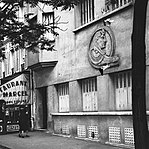La Comédie Italienne
1975 establishments in FranceBuildings and structures in the 14th arrondissement of ParisTheatres in Paris

La Comédie-Italienne is a theatre in the Montparnasse district of Paris, presenting Italian commedia dell'arte plays in French translation.The present-day Comédie-Italienne is situated at 19 rue de la Gaîté, where it was established in 1980 by the director Attilio Maggiulli, after the closing of his Teatrino Italiano, founded in 1975 on the avenue du Maine. The Comédie-Italienne remains the only Italian theatre in France and performs exclusively plays by Italian writers, classic and contemporary, in French translation.
Excerpt from the Wikipedia article La Comédie Italienne (License: CC BY-SA 3.0, Authors, Images).La Comédie Italienne
Rue de la Gaîté, Paris Paris (Paris)
Geographical coordinates (GPS) Address Website Nearby Places Show on map
Geographical coordinates (GPS)
| Latitude | Longitude |
|---|---|
| N 48.840085 ° | E 2.32405 ° |
Address
La Comédie Italienne
Rue de la Gaîté
75014 Paris, Paris (Paris)
Ile-de-France, France
Open on Google Maps










